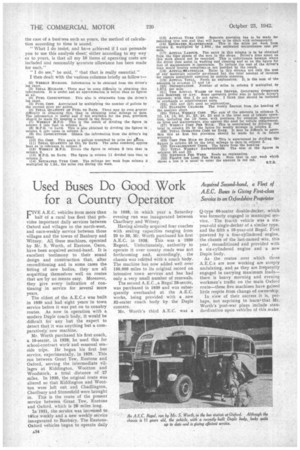Used Buses Do Good Work for a Country Operator
Page 36

If you've noticed an error in this article please click here to report it so we can fix it.
Acquired Second-hand, a Fleet of A .E.0 . Buses is Giving First-class Service to an Oxfordshire Proprietor
rIVE A.E.C. vehicles form more than I half of a rural bus fleet that prbvides important daily services between Oxford and villages to the north-west, and once-weekly service between those villages and the towns of Banbury and Witney. All these machines, operated by Mr. S. Worth, of Enstone, Oxon, have been acquired second-hand. It is excellent testimony to their sound design and construction that, after reconditioning and in some cases the fitting of new bodies, they are all acquitting themselves well on routes that are by no means easy. Moreover, they give every indication of continuing in service for several more years. The oldest of the A.E.C.s was built in 1930 and had eight years in town service before it was put on to country routes. As now in operation with a modern Duple coach body, it would be difficult for any but the expert to detect that it was anything but a comparatively new machine.
Mr. Worth purchased his first coach, a 16-seater, in 1928; he used this for school-contract work and seasonal seaside trips. He began his first bus service, experimentally, in 1929. This ran between Great Tow, Enstone and Oxford. serving the intermediate villages at Kiddington, Wootton and Woodstock, a total distance of 27 miles. In 1930, the original route was altered so that Kiddington and Wootton were left out and Chadlington, Charlbury and Stonesfield were brought in. This is the route of the present service between •Great Tew, Enstone and Oxford, which is 28 miles long.
In 1931, the service was increased to tirice weekly and a new weekly service inaugurated to Banbury. The EnstoneOxford vehicles began to operate daily
in 1938, in which year a Saturday evening run was inaugurated between Charlbury.and Wit ney.
Having already acquired four coaches with seating capacities ranging from 20 to 36, Mr. Worth purchased his first A.E.C. in 1938. This was a 1930 Regent. Unfortunately, authority to operate it over county roads was not forthcoming and, accordingly, the chassis was refitted with a coach body. The machine has now added well over 150,000 miles to its original record on intensive town services and has had only a very small number of renewals.
The second A.E.C.,a Regal 28-seater, was purchased in 1939 and was subsequently overhauled at the A.E.C. works, being provided with a new 32-seater coach body by the Duple concern.
Mr.. Worth's third A.E.C. was a Q-type 69-seater double-decker, which was formerly engaged in municipal service, The fourth vehicle was a sixyear-old single-decker of a similar type, and the fifth a 10-year-old Regal. First powered by a four-cylindered engine, the chassis of the last-named was, this year, reconditioned and provided with a six-cylindered engine and a new Duple body.
As the routes over which those A.E.C.s are now working are steeply undulating, and as they are frequently engaged in carrying maximum loads— there is heavy morning and evening workmen's traffic on the main Oxford route—these five machines have gained little respite from change 'of ownership.
In view of their success it is, perhaps, not suprising to learn•that Mr. Worth's "post-war plans include standardization upon vehicles of this make.




















































